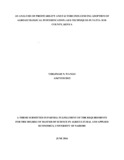| dc.description.abstract | Decline in soil fertility is considered as one of the most important causes of low agriculture productivity in sub-Sahara Africa. Initiatives to address soil fertility through use of inorganic fertilizers have yielded below average results in increasing productivity. Agro-ecological intensification (AEI) techniques use alternative knowledge and local materials to improve soil fertility and increase productivity. There is, however, little evidence of the economic viability and adoption levels of the AEI technique. There is a gap in understanding of the factors influencing the adoption of AEI techniques and the profitability of this innovation. This study assessed the profitability, level of adoption and factors influencing adoption of agro-ecological intensification technique in Yatta Sub-county, Kenya. Household survey data on demographic characteristic, soil management practices, production and yield from a sample of 140 randomly selected households in Yatta Sub-county was collected. Gross margin analysis and Poisson regression model were used to analyze the data on profitability and factors influencing adoption respectively.
Farmers adopted various components, farm yard (95%), crop diversity (77%), compost manure (76%), utilization of crop residue (72%), cover cropping (57%) and crop rotation (54%). About 40 percent of farmers had adopted at least one component of the AEI techniques while 28 percent of surveyed farmers had fully adopted all components studied. Gross margin analysis showed that farmers practicing AEI technique increased their yield and attained higher profits than farmers without the technique. Results from the Poisson Regression model showed that farm income, age, level of education of household head, and number of extension contacts, among other factors, had significant influence in adoption of the agro-ecological intensification techniques.
These findings give insight into the potential for further development of agro-ecological intensification techniques. Policies that enhance adoption through targeted extension should be encouraged.
Key words; Agro-ecological intensification (AEI) technique, adoption, profitability, Poisson model | en_US |



